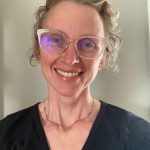Energy healer and somatics expert Cheryl Pallant, PhD, shares ways to connect our bodies, minds, and senses with the earth to heal ourselves and the world.
Cheryl Pallant, PhD, is an energy healer, professor, poet, somatics coach, and dancer. She is the author of several books in nonfiction and poetry, most recently Writing and the Body in Motion: Awakening Voice through Somatic Practice (McFarland and Co.) and the newly released Ecosomatics: Embodiment Practices for a World in Search of Healing with Inner Traditions. She facilitates her popular workshop and retreat, Writing From the Body, which blends writing with movement, meditation, and somatic awareness.
We spoke with Cheryl about Ecosomatics, which was reviewed in the May/June 2023 issue of Spirituality+Health.
S+HI: Ecosomatics is so poetic, both impressionistic and declarative. Tell us a little about your writing process. How did you begin this book in particular? Where did the journey take you this time?
Pallant: Typically I agree to writing a book, which is a sizable commitment of time and energy, from a powerful urge to do so, when the idea for the book insists upon being written. What was unusual this time was that I was in the middle of writing a poetry collection and preferred not to be interrupted. The urge was so insistent, however, I put the poetry aside.
The poetry was drawn from sensing my body, the field outside my body, and a participation in the ecosystem of language. Some of that same sensibility fed into Ecosomatics, along with the urgency that we each must do something to deal with the climate crisis. Writing this book is one of my actions. Its writing reinforced the importance of showing up fully within oneself with more expansive perceptions for personal and collective health. The home of the body and the home of this planet are interdependent, and the writing furthered that relationship.
Would Ecosomatics have been different 15 or 20 years ago, before the era of social media and Zoom offices? Do we live more in our heads now than in our bodies?
Too many of us are disembodied, even from before social media and Zoom. We live from the neck up, in our heads, distracted by thought and distant from the twinges, nudges, flutters, intuition, and all the rich phenomena of our bodies that provide valuable information. Similarly, we tend to have little awareness of the land of which we are a part. Many believe that nature is outside us, perhaps miles away at a park. It takes courage and sensitivity to live with the rhythms of nature, to allow all of who we are to emerge, and to see how the inner and outer currents interact.
In the book, you strikingly write, “Every one of us has experienced a wound that impedes the flow of our vital energy.” This connects to how our cultural conversation has widened in recent years to include experiences of trauma and mental health issues. What do you think is driving this opening?
We’re more open to the conversation for many reasons. I’ll mention a few. The women’s movement allowed women to name domestic abuse as unacceptable behavior, no longer sanctioned by marriage. The Vietnam War turned the idea of combat fatigue into PTSD, an acknowledgement of the seriousness of soldiers’ mental wounding. Meditation and yoga became welcomed as healthy practices. Therapy became a useful, normalized route to health, not something to be ashamed of as it once was.
Engaging in a creative or meditative practice shows us up close what an unimpeded flow of vital energy feels like. Reactivity is more likely to result from a restricted and unexplored mind and body and, in worse case situations, that lack of awareness leads to harm and abuse. Many of us expect life satisfaction and are willing to do the necessary work.
You write that mindfulness is too easily dispatched, touted as a quick fix. You remind us that it is not just a mental practice, but also a physical practice. Is mindfulness a good starting point for folks who ache to make big changes? How so?
It’s a great starting point. Meditation is about noticing what is taking place bodily, which may be a tendency toward mental chatter. By noticing the breath for a few minutes or going for a meditative walk, the senses awaken. We become more alert to the present moment, to our tiredness or hunger, to the flight of a robin, the rumble of a truck, or the wind blowing our hair. Aligning our senses to what’s happening in the present moment settles the nervous system, which then allows us to tap into more of who we are.
Your statement that “competence fans the ego” undoubtedly resonates with a lot of people. But competence itself can be beneficial when it is applied for the greater good. Is it better to be sort of okay at cultivating ecosomatics, or exceptional at small-scale change?
More competence is needed and welcome. It becomes problematic if it keeps us from trying anything new, if we’re unwilling to step out of our comfort zone to explore what else is possible. I applaud being “sort of okay” at cultivating ecosomatics. It’s essential. We all have to start somewhere for learning and growing to occur. I would also applaud being exceptional at small-scale changes. But we need to remain humble, which keeps us in touch with our body, nature, and the environment. We need to be aware of both subtle and large-scale changes. Planetary and personal health depend on us being humbly responsive and effective, compassionate stewards.
Read our review of Ecosomatics here.






